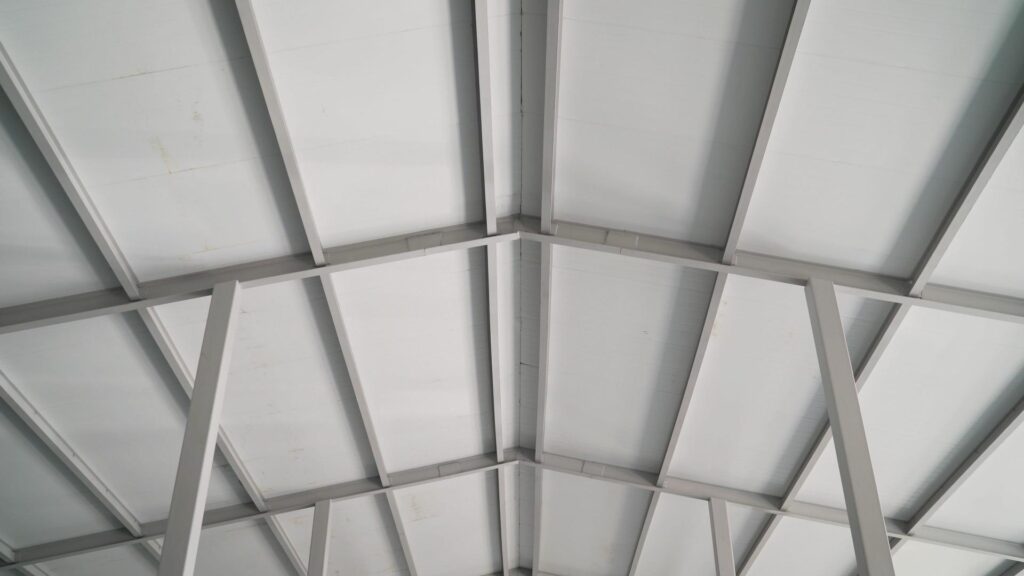
Contents
When considering budgeting for steel structures, it’s crucial to recognize that the choice of steel grade can greatly impact both the cost and the performance of your project. However, this is just the tip of the iceberg. Understanding how various factors like design complexity, site conditions, and maintenance requirements intertwine to influence your budget can make or break the financial success of your steel structure endeavor. Stay tuned to uncover the intricate web of considerations that go into effectively managing your budget for steel structures.
Key Takeaways
- Consider the impact of steel grade on performance and cost.
- Anticipate scope changes for cost mitigation.
- Factor in fabrication and transportation costs.
- Address site conditions and foundation design.
- Plan for installation and maintenance requirements.
Project Scope
When determining the project scope for budgeting steel structures, consider the specific requirements and objectives that need to be addressed. Proper budget allocation is essential to ensure that the project stays within financial limits while meeting all necessary specifications.
Begin by outlining the project timeline and breaking down tasks into manageable segments to track progress effectively.
Scope changes can have a significant impact on the budget allocation for steel structures. It’s vital to anticipate potential modifications and plan accordingly to mitigate any adverse effects on costs. By staying proactive and adaptable, you can navigate scope changes without compromising the project’s financial integrity.
Unforeseen costs pose a challenge in budgeting for steel structures. Factors such as material price fluctuations, labor shortages, or unexpected site conditions can lead to additional expenses. It’s advisable to set aside a contingency fund to buffer against unforeseen costs, ensuring that the project remains financially viable even in the face of unexpected challenges.
Material Selection
When selecting materials for your steel structure, you must consider the impact of different steel grades on the project’s performance and budget. Explore cost-effective options that meet your structural requirements without compromising quality.
Additionally, prioritize durability considerations to ensure the longevity and resilience of your steel structure.
Steel Grade Impact
Choosing the right steel grade is crucial in determining the structural integrity and performance of steel structures. Steel grades play a critical role in ensuring the desired structural performance of a building while considering its environmental impact. The selection of steel grade influences factors such as strength, ductility, toughness, and weldability, all of which directly impact the structural performance.
Various steel grades offer different levels of corrosion resistance, durability, and environmental friendliness, affecting the overall environmental impact of the structure. By selecting a steel grade that matches the specific requirements of the project, you can enhance the structural performance while reducing the environmental footprint.
Understanding the properties and characteristics of different steel grades is important in making informed decisions that balance structural needs with environmental considerations.
When evaluating steel grades, consider factors such as the project location, exposure to environmental elements, and the intended lifespan of the structure. By carefully analyzing these aspects, you can choose a steel grade that meets the structural demands and aligns with sustainable and environmentally friendly practices.
Cost-Effective Options
Explore material selection strategies to pinpoint cost-effective options for steel structures. When aiming to achieve budget-friendly decisions without compromising quality, integrating value engineering and exploring alternative solutions can be advantageous.
Here are three key factors to keep in mind:
Value Engineering: Participate in a detailed value engineering process to enhance the cost-performance ratio of the steel structure. By closely examining every aspect of the design and construction, you can pinpoint areas where cost savings can be achieved without compromising structural integrity.
Alternative Solutions: Explore alternative materials or construction methods that align with eco-friendly practices and green technologies. Utilizing creative solutions can reduce initial costs and result in long-term savings through energy efficiency and reduced environmental impact.
Lifecycle Cost Analysis: Perform a thorough lifecycle cost analysis to assess the total ownership cost throughout the structure’s lifespan. By taking into account maintenance, repair, and operational expenses in addition to initial construction costs, you can make well-informed decisions that prioritize cost-effectiveness in the long term.
Durability Considerations
To ensure peak performance and longevity of steel structures, careful consideration of material selection is essential, especially when focusing on durability factors.
When evaluating material options for steel structures, weather resistance stands out as a key aspect to ensure the longevity of the construction. Opting for materials that offer high weather resistance can greatly reduce maintenance costs over the structure’s lifespan.
Additionally, selecting materials that align with environmentally friendly practices benefits the environment and enhances the structure’s durability. By integrating eco-friendly materials, you contribute to the longevity of the steel structure while reducing its environmental impact.
Construction techniques play a crucial role in ensuring the structural integrity of steel buildings. Proper construction methods can enhance the durability of the structure by minimizing vulnerabilities to external factors.
Therefore, when making material selections for steel structures, consider both weather resistance and sustainability benefits to ensure the longevity and structural integrity of the construction.
Design Complexity
When evaluating the budget for steel structures, it’s important to assess the impact of design complexity on overall project costs.
Design complexity plays a pivotal role in determining the financial requirements of a steel structure project. Here are three key factors to take into account:
Structural Integrity:
Intricate designs often require specialized engineering solutions to ensure the structural integrity of the steel structure.
Complex designs may involve unique load-bearing requirements or unconventional shapes, necessitating advanced analysis and detailing.
These additional engineering considerations can raise costs significantly but are essential for ensuring the safety and stability of the structure.Aesthetic Appeal:
Highly complex designs are often chosen to enhance the visual impact of a steel structure.
Incorporating intricate architectural elements or unique geometries can elevate the aesthetic appeal of the building.
However, these design features typically involve custom fabrication and installation processes, which can increase expenses.
Balancing aesthetic aspirations with budget constraints is essential to achieving a harmonious and cost-effective design.Design Flexibility and Construction Efficiency:
While complex designs offer creative freedom, they can also impact construction efficiency.
Elaborate designs may require intricate assembly sequences, specialized equipment, or additional labor hours, all of which influence construction timelines and costs.
Opting for a design that balances creativity with practicality is key to managing expenses while delivering a structurally sound and visually appealing steel structure.
Site Conditions
Evaluating the impact of site conditions on steel structure projects is essential for accurate budget estimation and project planning. Soil analysis plays a pivotal role in determining the type of foundation required for the steel structure. Conducting a thorough soil analysis helps in understanding the bearing capacity of the soil, which directly influences the design and cost of the foundation. Different soil types have varying load-bearing capacities, affecting the size and depth of the foundation needed.
Weather factors also significantly influence steel structure projects. Harsh weather conditions can lead to delays in construction, affecting the overall project timeline and budget. Extreme temperatures, high winds, or heavy rainfall can all pose challenges during the construction phase. Incorporating weather considerations into the budgeting process is vital for managing risks and keeping the project on track.
Furthermore, soil and weather conditions are interrelated, as certain soil types may be more susceptible to erosion or instability during adverse weather conditions. This connection underscores the importance of a thorough site assessment that considers both soil properties and typical weather patterns in the region.
Fabrication Costs
A thorough analysis of fabrication costs is vital for accurately estimating the budget of steel structure projects. When it comes to fabrication costs, several key factors need to be considered to ensure a successful and cost-effective project.
Here are three critical aspects to focus on:
Pricing strategies: Implementing effective pricing tactics can greatly impact the overall fabrication costs of a steel structure. By analyzing market trends, material costs, and labor expenses, you can develop a pricing strategy that aligns with your budgetary goals. This strategic approach will help you enhance costs without compromising on quality.
Supplier negotiations: Engaging in strategic discussions with suppliers is essential in controlling fabrication costs. By building strong relationships with reliable suppliers, you can negotiate favorable terms, discounts, and delivery schedules. This proactive approach aids in reducing costs and ensures timely procurement of materials, avoiding project delays.
Quality control: Maintaining stringent quality control measures throughout the fabrication process is vital for cost management. By conducting regular inspections, quality checks, and audits, you can identify and resolve any issues early on, preventing expensive rework or delays. Prioritizing quality control ensures the structural integrity of the project and contributes to cost savings in the long term.
Transportation Expenses
Consider the logistics of transporting materials and components when calculating the total budget for steel structure projects. Freight logistics and delivery costs are significant factors that can impact the overall expenses. The transportation of steel components involves various complexities that need to be accounted for in the budgeting process.
Shipping challenges such as delays, damages, or route modifications can incur additional costs. It’s essential to anticipate these potential obstacles and allocate resources accordingly to mitigate any financial repercussions. Import fees also play an important role in transportation expenses, especially if materials are sourced internationally. Understanding the import regulations and associated costs is crucial for an accurate budget projection.
Collaborating closely with transportation providers and freight forwarders is recommended to manage transportation expenses effectively. They can offer valuable insights into optimizing routes, consolidating shipments, and identifying cost-saving opportunities. By leveraging their expertise, you can streamline the transportation process and potentially reduce delivery costs.
Installation Requirements
When planning the budget for steel structures, taking into account the specific installation requirements is vital to accurately estimate project costs. Understanding the nuances of installation can help prevent unexpected expenses and delays. Here are three key aspects to ponder:
Foundation Requirements: Verifying the foundation meets the specifications for the steel structure is indispensable for stability and longevity. Factors such as soil composition, load-bearing capacity, and environmental considerations must be assessed to meet safety standards and prevent structural issues in the future.
Safety Regulations: Adhering to safety regulations is crucial during the installation process. Compliance with industry standards and local codes ensures workers’ well-being and avoids potential fines and legal complications. Prioritize safety training and equipment to create a secure working environment.
Assembly Process and Skilled Labor: The efficiency of the assembly process significantly influences installation costs. Hiring skilled labor with experience in steel structure construction can streamline the project timeline and reduce the likelihood of errors. Investing in trained professionals ensures a higher quality installation that aligns with industry best practices.
Maintenance Considerations
Maintaining regular checks and timely repairs is crucial for preserving the structural integrity and longevity of steel structures. Corrosion prevention plays a vital role in maintaining the durability of steel components. Routine inspections for signs of corrosion, such as rust or deterioration of paint coatings, are imperative to catch and address issues early on. Neglecting these maintenance tasks can lead to more extensive damage and higher repair costs in the long run.
When it comes to paint coatings, choosing high-quality coatings initially can greatly extend the lifespan of the steel structure and reduce the frequency of repainting needed. However, periodic inspection and maintenance of these coatings are still crucial to ensure they are intact and provide adequate protection against corrosion.
Below is a table summarizing key maintenance considerations for steel structures:
| Maintenance Consideration | Importance |
|---|---|
| Regular Inspections for Corrosion | High |
| Quality of Paint Coatings | Medium |
| Timely Repairs | High |
| Repair Costs | High |
| Corrosion Prevention Methods | High |
Wrap-Up
When budgeting for steel structures, remember to carefully assess all key factors. From material selection to maintenance considerations, each aspect plays an essential role in ensuring the success of your project.
By taking a thorough approach and considering all variables, you can avoid potential pitfalls and achieve your desired outcome.
So, don’t let the sound of a ticking clock derail your plans; stay focused on the task at hand and watch your project flourish.
Recent Posts
What Are the Benefits of Tailored Metal Structures?
Imagine a well-crafted suit tailored to fit perfectly; that’s how tailored metal structures operate in
3 Tips for Long-lasting Metal Commercial Structures
When it comes to metal commercial structures, you’ll want to focus on a few key
Explore Benefits of Residential Metal Structures
It’s funny how you might stumble upon the idea of residential metal structures just when




